Modern Cabin Interior Design: Principles and Trends
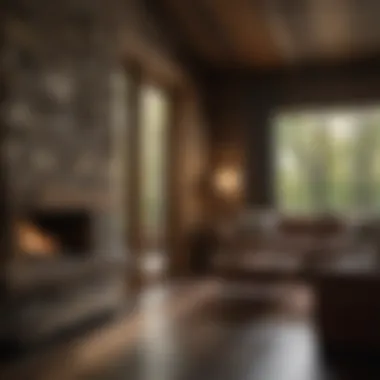
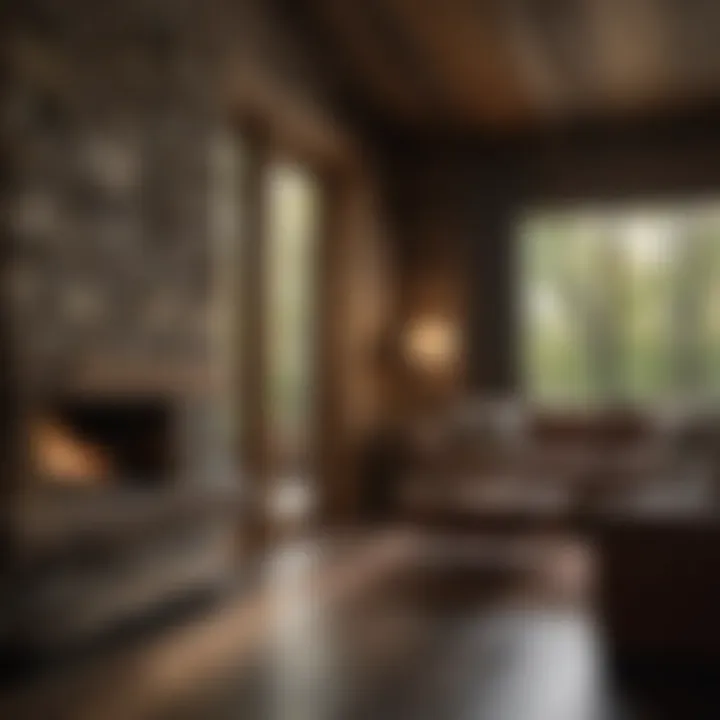
Intro
When stepping into the world of modern cabin interior design, one is often greeted by a unique blend of rustic charm and contemporary elegance. This style captures the spirit of cozy retreats while making sure that functionality meets aesthetics, resulting in spaces that don't just look good, but feel good too. Embracing this design is about more than simply throwing together some good-looking furniture; it's about creating an inviting atmosphere where memories can flourish.
In recent years, interest in cabin living has surged, fueled by a desire for escapes from the hustle of daily life. Homeowners today seek more than just a shelter; they crave havens that reflect their individual style and support sustainable living practices. With this article, we will navigate through the principles that shape modern cabin interiors, the materials that breathe life into these designs, and the artistic elements that provide warmth and charm.
The journey doesn't end with foundational designs; we will also explore personal touches that make a cabin resonate with its inhabitants’ identities. By the time you finish reading, you'll be armed with the knowledge to transform any cabin into a cozy yet sophisticated retreat that feels distinctly yours.
Interior Design Tips
Trendy Design Ideas
Modern cabin interiors are often characterized by a harmonious balance of natural elements and contemporary design techniques. Think about large windows framing views of towering trees outside or using reclaimed wood for accents and furniture. The goal here is to create a seamless transition between the interior and the great outdoors.
- Use of Natural Materials: Opt for materials such as stone, wood, and leather to keep the atmosphere grounded.
- Incorporating Nature: Bring the outside in with potted plants or herb gardens on windowsills.
- Open Spaces: Design interiors that encourage flow, such as open kitchens connected to living areas.
These ideas aim to bridge the gap between comfort and modernity. A well-placed rocking chair on a porch, for instance, can be a perfect spot for morning coffee, while modern art additions can invoke conversation during gatherings.
Color Schemes and Combinations
The color palette in modern cabin design plays a significant role in establishing mood. Neutral tones mixed with deep forest greens or soft sky blues can create a serene environment. Consider opting for a mixture of:
- Earthy Tones: Browns, greens, and rust colors mimic the landscapes surrounding the cabin.
- Accent Colors: Soft blues or bold yellows can elevate the space and add a bit of personality.
By judiciously selecting colors, you can enhance the feeling of coziness while ensuring that your cabin reflects an inviting and modern aesthetic.
Furniture Arrangement Techniques
Arranging furniture in a cabin requires consideration of both practicality and comfort. To keep the space inviting, consider the following tips:
- Focus on Functionality: Ensure that furniture placement facilitates conversation and movement, avoiding clutter.
- Zone Each Area: Use rugs or furniture groupings to define spaces for cooking, dining, and lounging.
- Layering Textures: Incorporate different materials such as soft throws, woven coasters, and wooden tables to create depth in the design.
*"A well-designed space invites you to linger, to live fully, and to share experiences with those you cherish."
Entertaining Essentials
Table Setting Inspiration
Modern cabins can also double as perfect venues for hosting gatherings. When it comes to table settings, consider a rustic approach that keeps it chic:
- Natural Linens: Using linen tablecloths or runners adds a touch of elegance while maintaining a down-to-earth vibe.
- Unique Tableware: Look for artisanal plates or hand-crafted glasses to set a memorable dining experience.
- Seasonal Centerpieces: Incorporate items like wildflowers in mason jars or pine cones for an organic feel.
Menu Planning Tips
For a successful celebration, focus on a menu that complements the cabin experience. Think hearty dishes that can be shared, such as:
- Homemade stews that warm the heart on a chilly evening.
- Grilled vegetables and meats served family-style for a communal feast.
- Decadent desserts, like berry crumbles, that evoke cozy, nostalgic feelings.
Party Theme Suggestions
Playful themes can invigorate any gathering:
- Campfire Nights: Serve s'mores, hot chocolate, and acoustic tunes.
- Seasonal Celebrations: Decorate based on the holidays, using natural elements like pine branches or autumn leaves.
Inspirational Home Decor
Stylish Home Decor Pieces
To infuse personality into your modern cabin, it’s all about the details. Incorporating unique decor can make a significant impact:
- Handcrafted Items: Whether it's a locally-made rug or a sculptural piece, these touch can resonate meaning.
- Personal Collections: Display travel souvenirs or family heirlooms to tell your story.
Wall Art and Prints
Art has the power to transform spaces. Consider selecting:
- Nature Photography: Emphasizes the connection to the outdoors.
- Abstract Works: Introduce contemporary flair that contrasts against rustic elements.
Lighting and Ambiance
Proper lighting is crucial in setting the mood:
- Layered Lighting: Combine ambient lights (overhead) with task lights (reading lamps) and accent lights (wall sconces).
- Candles: Add warmth and intimacy, especially during gatherings or quiet evenings.
Outdoor Living Spaces
Patio Design Inspiration
Don’t forget the magic of outdoor spaces. Design patios that enhance the overall experience:
- Seating Arrangements: Create cozy nooks with plush cushions and throws for late-night talk.
- Fire Pits: They encourage gathering and warmth, making every evening memorable.
Outdoor Furniture Trends
Choose durable furniture that withstands nature but doesn’t skimp on style. Materials like teak or powder-coated metal could be ideal—look for pieces that invite relaxation and socializing.
Creating Cozy Outdoor Retreats
Envelop the outdoors in comfort:
- Lighting: Fairy lights or lanterns can lift the ambiance after sunset.
- Warm Textiles: Keep outdoor throws handy for cooler evenings, ensuring guests remain cozy as they sip on their favorite drink.
By piecing together these elements, homeowners can truly bring the modern cabin interior design to life, creating a dwelling that is not just a home but a cherished retreat.
Understanding Modern Cabin Design
Understanding modern cabin design is pivotal for anyone looking to create a space that resonates with warmth, simplicity, and a touch of luxury. It’s not merely about aesthetics; it revolves around weaving functionality with the serene essence of nature. By grasping the core elements of this design philosophy, homeowners and interior aficionados can craft environments that feel both organic and sophisticated, perfectly aligning with today’s lifestyle.
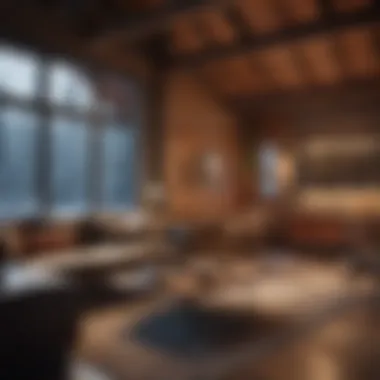

Defining the Modern Cabin Aesthetic
The modern cabin aesthetic centers on a few key themes that set it apart from traditional styles. First off, there’s a significant emphasis on clean lines and uncluttered spaces. Shapes are typically geometric, which projects a sense of calm and intention. This design approach encourages the use of natural materials like wood and stone while ensuring that any embellishments remain understated.
In addition, color plays a crucial role in shaping this aesthetic. Earthy tones like deep greens, browns, and soft whites enhance a cabin vibe by connecting indoor living with the outdoor landscape. One might achieve this look through the strategic selection of furniture and decorative elements that harmonize with the surrounding environment.
The usage of large windows is also a hallmark of this style, inviting the outdoors inside and allowing for the beauty of nature to be part of the interior narrative. By fostering this connection, the home not only feels spacious but also imbues an aura of tranquility that can be hard to find in urban settings.
Historical Context and Evolution
To fully appreciate modern cabin design, it's valuable to understand its historical roots. Initially, cabins were constructed as simple, functional dwellings utilized by early settlers and loggers. Their designs were practical, formed from readily available materials and aimed at providing shelter above all.
As time rolled on, particularly during the 20th century, cabins began to evolve. Influences from the Arts and Crafts movement paved the way for a more artisan approach to cabin building. Craftsmen started valuing handcrafted elements and a closer relationship to nature in their designs.
By the late 20th century and into the early 21st century, modern cabin design morphed into what we see today—a blend of traditional materials with modern sensibilities. Architects and designers have augmented the original aesthetic by incorporating sustainable practices, which is a crucial consideration given our changing environment.
In summary, modern cabin design is not just about stylistic choices; it reflects an ongoing dialogue between necessity, craftsmanship, and nature, evolving to meet the needs of contemporary lifestyles. As we endeavor to explore the further intricacies of this design style, one can see it’s about creating personal spaces that delight the senses and warm the heart.
Core Principles of Modern Cabin Interior Design
Modern cabin interior design blends comfort with aesthetics, turning mere living spaces into warm retreats that reflect the surrounding environment. This article delves into the core principles that drive modern cabin interiors, spotlighting minimalism and functionality, integration with nature, and personalization and comfort. Each pillar plays a crucial role in crafting the ultimate cabin experience, ensuring that form meets function without sacrificing style.
Minimalism and Functionality
At the heart of modern cabin design lies a commitment to minimalism and functionality. This doesn’t mean stripping a space of character; rather, it’s about paring down to what truly matters. In a cabin, where space can be limited, functionality must take precedence over ornate designs. Furniture that serves dual purposes—like a sofa bed or a table with storage—maximizes utility, while clean lines and uncluttered spaces promote a sense of calm.
- Key Benefits:
- Enhances space efficiency
- Reduces stress with simplicity
- Encourages thoughtful purchases of durable items
A minimalist approach also enhances the natural beauty of the surroundings. By keeping the design simple, the focus shifts to the views outside—whether that’s sprawling forests, tranquil lakes, or majestic mountains. In this way, forms and colors become a backdrop rather than a distraction, allowing the cabin’s natural charm to shine.
Integration with Nature
The integration of nature within modern cabin design is not simply a design trend; it is a philosophy that recognizes the profound impact the natural environment has on our well-being. This principle encourages the use of large windows that invite sunlight and frame outdoor views, fostering a connection with the landscape.
Architectural choices like open floor plans and natural materials work in harmony to bridge the gap between indoor and outdoor spaces. Often, elements such as stone fireplaces or reclaimed wood beams add to the kinetics of the cabin, blending seamlessly with the exterior environment.
- Considerations for Integration:
- Choose natural finishes rather than synthetics
- Create outdoor spaces that extend the interior
- Use eco-friendly materials
Integrating elements of nature into the cabin also promotes sustainability. Building an atmosphere that celebrates local flora and fauna leads to a deeper appreciation of the environment, aligning perfectly with the overarching ethos of modern cabin living.
Personalization and Comfort
While minimalism and natural integration are key, the final principle—personalization and comfort—holds equal weight in modern cabin design. A cabin should feel like a sanctuary; it must exude warmth and personality. Whether it’s through the selection of colors, textiles, or artwork, every element can reflect the inhabitants' unique style and values.
- Personalization Strategies:
- Use family heirlooms or travel artifacts as decor
- Incorporate local crafts that tell a story
- Choose colors that resonate emotionally
Comfort should never be overlooked. Plush, inviting sofas, layered textiles in the form of quilts or throw pillows, and soft lighting create an atmosphere that is welcoming after a long day outdoors. Ultimately, when personal touches are added to a well-thought-out space, it transforms mere shelter into a home.
"Your home should tell the story of who you are, and be a collection of what you love."
Bringing these elements together—functionality, nature, and personal comfort—creates a modern cabin interior that is not only visually appealing but also exceptionally livable. By grasping the essence of these core principles, homeowners can craft spaces that sustain them through the changing seasons of life.
Key Materials in Modern Cabin Interiors
When diving into modern cabin interior design, the materials used hold great weight. They are not mere building blocks; they embody the essence of the cabin, infusing it with character, warmth, and sustainability. Choosing the right materials not only impacts aesthetics but also defines functionality and comfort levels. In this section, we will explore the foundational materials that make modern cabins stand out, considering their distinct qualities, benefits, and integral roles in designing a serene retreat.
Wood: The Heart of Cabin Design
Wood serves as the quintessential element in cabin design, and it is hard to argue otherwise. From the sturdy beams overhead to the rich hardwood flooring underfoot, *wood brings a sense of connection to nature.* It creates a cozy ambiance that invites relaxation, a fundamental characteristic for anyone looking to escape the hustle and bustle.
Additionally, the versatility of wood is unmatched. Different types such as cedar, pine, or oak lend unique flavors to a cabin's interior. Cedar, for example, is known for its pleasant aroma and natural resistance to decay, making it a practical and aromatic choice for both structural and decorative needs.
Using reclaimed wood is becoming a popular choice among designers and homeowners. It not only provides a rustic feel but also echoes sustainability, permitting individuals to feel good about their environmental impact. The warmth of the raw wood grain, when paired with modern finishes, creates a stunning contrast that speaks to both down-to-earth charm and contemporary sophistication.
Stone and Its Natural Charm
When it comes to bringing an organic feel into a cabin, stone effortlessly carves its niche. This material introduces a sense of permanence and strength. Whether it's a rugged fieldstone fireplace or sleek slate tiles adorning the bathroom, stone accentuates a cabin's structure beautifully. Apart from aesthetics, stone also offers practical benefits; it helps in regulating indoor temperatures and provides insulation.
Some homeowners opt for a mix of stone types, blending textures and colors to achieve a captivating infusion of the natural world. For instance, pairing smooth river stones with rough-cut granite can create a visually appealing contrast that evokes a sense of being outside, in the midst of nature.
Moreover, local stone can often be sourced to minimize transportation costs and ecological footprints, supporting local economies while enhancing the authenticity of the cabin’s aesthetic. Building a wall or using stone bases for furniture pieces can introduce a striking artistic element that catches the eye without overwhelming the space.
Metal Accents for Contemporary Flair
In an age of modernity and innovation, the use of metal accents in cabin interiors has swiftly gained traction. Steel beams subtly embedded in the structure or copper light fixtures hanging overhead add an urban edge that harmonizes with the more traditional wood and stone found in cabin design.
Metal not only contributes to a modern chic vibe; its durability plays a big role in practicality. Stainless steel appliances or metal furniture pieces often stand up to the rigors of everyday life, offering longevity and resilience. Many homeowners are fond of incorporating items with patina or aged finishes, as they provide an appealing contrast to the smoothness of wood and the roughness of stone.
Adding metal art pieces or simple metallic accessories can be a game-changer for a cabin’s aesthetics. Think matte black vases or brushed nickel drawer handles that catch the light just so. Such accents offer visual interest, enriching the overall feel without feeling too flashy or out of place.
"The beauty of cabin design rests in its ability to blend the rusticity of nature with the sophistication of modern living. Choosing the right materials is key to achieving that balance."
Ending
In mastering modern cabin interior design, the right materials govern everything from warmth and texture to sustainability and practicality. Wood, stone, and metal serve as principal players in this domain, each with their unique charms and benefits. A well-chosen combination can deliver an inviting space that reflects personal style while acknowledging the natural beauty surrounding it.
Color Palette in Cabin Interiors
The choice of color palette plays a foundational role in cabin interior design. It has the power not only to define the mood of a space but also to highlight architectural features and elements of nature surrounding the cabin. An effectively curated color scheme can create a seamless flow, enhancing the overall aesthetic while serving practical functions. Homeowners and designers should give serious thought to how colors interact, as this can greatly affect the warmth and inviting nature of a cabin retreat. With a cabin's allure often rooted in its natural surroundings, the right palette can bridge the interior with the outside world, making it feel cohesive and harmonious.
Earthy Tones and Their Impact
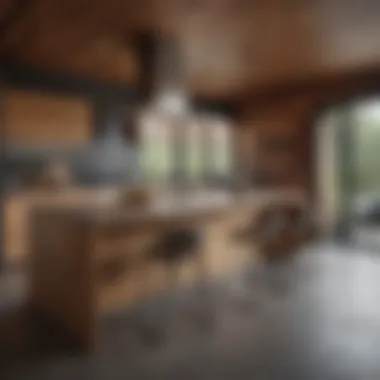
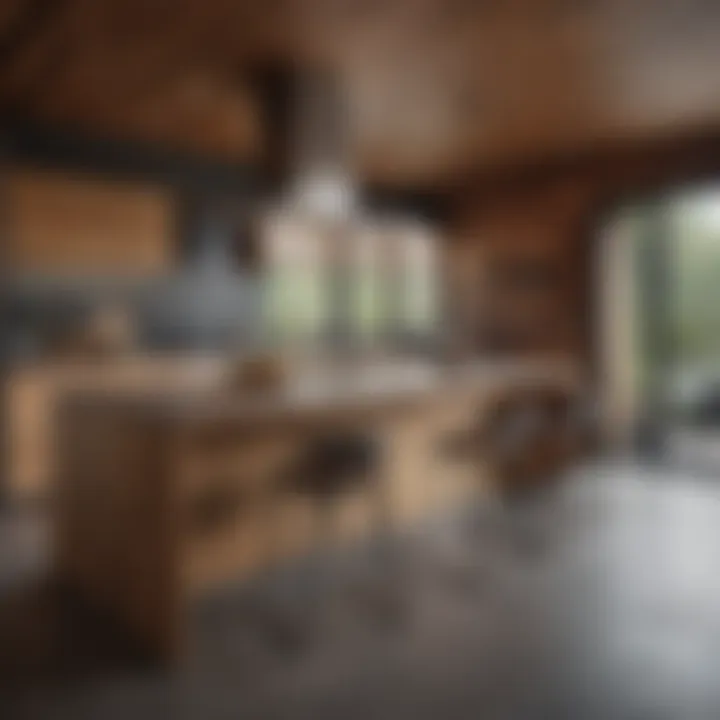
Earthy tones—such as browns, greens, and rust—are some of the most notable colors used in modern cabin designs. These shades not only evoke a sense of calm but also bring the essence of the outdoors inside. To illustrate, consider how a soft olive green can reflect the lush trees just outside your window.
- Connection to Nature: Earthy colors create a sensory connection; they symbolize stability and grounding, aligning beautifully with the cabin lifestyle that often emphasizes simplicity and harmony with nature.
- Warmth and Coziness: Shades of brown, reminiscent of wood and soil, can produce a warm atmosphere. A chestnut hue, for example, adds depth and comfort, making a space feel welcoming, while still keeping it stylish.
- Versatility in Combinations: Earthy tones serve as an excellent base for more vibrant accents. They complement brighter colors without overwhelming the senses, allowing for creative expression throughout design choices.
"Color is the keyboard; the eye is the harmonica. The artist is the composer." - Wassily Kandinsky
This quote reflects the importance of colors in design. Thus, when considering earthy tones, let them guide your cabin’s identity.
The Role of Highlights and Contrasts
While earthy tones serve as neutral and grounding elements in cabin interiors, highlights and contrasts bring life and energy to a space. The clever use of contrasting colors can emphasize certain areas or features, capturing attention in a subtle manner.
- Accent Colors: Use brighter shades like mustard yellow or deep navy as accents against a backdrop of soft browns and greens. This method can create focal points, drawing the eye towards art pieces or furniture without overpowering the entire room.
- Dynamic Textures: Beyond colors, mixing textures—like a sleek metallic lamp against a wooden table—creates depth. This interplay may highlight features within the color palette, making the design more intricate and layered.
- Mood Alterations: Highlights can also influence the mood. Incorporating warmer hues in accessories, like cushions or artwork, can evoke a sense of cheer and coziness, perfect for social spaces and gatherings.
Spatial Layout and Functionality
When discussing modern cabin interior design, one cannot overlook the significance of spatial layout and functionality. It serves as the backbone for how the cabin will feel and operate. A well-thought-out space can enhance comfort, promote flow, and foster a sense of connection between rooms, while a poorly planned layout can make even the coziest cabin feel cramped and uninviting.
The primary objective here is to create environments that cater to both relaxation and socialization. For example, consider how the arrangement of furniture in communal spaces like the living room or kitchen can invite conversation and warmth. By incorporating an open layout, homeowners can create inviting spaces where everyone feels right at home. In essence, making thoughtful decisions about spatial layout contributes immensely to one’s cabin experience.
Key elements to consider in spatial layout include:
- Flow: Ensure there’s a natural movement between rooms, preventing bottlenecks or areas that feel obstructed.
- Zoning: Designate specific areas for different activities, such as a reading corner in the living room or a workspace in a guest room.
- Scale: Take into account the proportions of furniture and decor relative to the dimensions of the rooms, avoiding overcrowding or excessive empty space.
Focusing on these elements means making practical choices. For instance, opting for multi-functional furniture like a sofa bed or an expandable dining table can make the most out of smaller spaces.
"A well-designed space is like a well-written story; it flows seamlessly from one chapter to the next."
Open Concept Living
One of the hallmarks of modern cabin design is the notion of open concept living. This approach breaks down barriers between traditionally closed-off spaces, merging the kitchen, dining, and living areas into one cohesive environment. The advantages of this design style are plentiful. Not only does it enhance connectivity among family members and guests, but it also takes full advantage of natural light.
In many modern cabins, large windows and sliding doors become central features, allowing nature to infiltrate the interiors. When setting up an open floor plan, remember:
- Define Areas with Rugs: Use area rugs to delineate different spaces while maintaining overall openness.
- Strategic Furniture Placement: Position seating arrangements to promote conversation without isolating individuals.
- Create Visual Interest: Incorporate varied materials and textures to define spaces while retaining a cohesive look.
Such designs contribute significantly to the overall ambiance, promoting inclusivity and ease.
Creating Multi-Functional Spaces
In today's compact living situations, the ability to adapt spaces for multiple purposes has become not only desirable but essential. Creating multi-functional spaces allows homeowners to maximize their use of the cabin without sacrificing style or comfort. Here are a few ideas:
- Guest Room with Work Nook: A dual-purpose guest room can accommodate visitors while providing a small workspace, equipped with a desk that can be folded away when not in use.
- Dual-Use Dining Area: Feature a dining table that can serve as both a family dinner setting and a game table for social gatherings. Foldable or stackable chairs can further increase utility.
- Living Room Library: Integrate bookshelves into the living area to store books and decor, making the space both cozy and functional.
In essence, the goal is to ensure that every square inch of the cabin serves a purpose, contributing to both form and function. By embracing the concept of versatility, homeowners can enjoy a modern cabin that meets their diverse needs.
Sustainable Practices in Modern Cabin Design
Sustainable practices are increasingly vital in modern cabin design, especially as awareness about environmental issues grows. The emphasis on creating eco-friendly cabins not only preserves natural resources but also enhances the quality of life for residents and visitors alike. Incorporating sustainable elements into cabin interiors can lead to not just a stylish retreat, but one that nurtures the environment, fulfilling a vital role in the evolving landscape of construction and design.
Using Reclaimed Materials
Reclaimed materials play a big role in modern cabin interior design. They provide a unique aesthetic and a rich history that new materials simply can’t replicate. When a cabin features reclaimed wood, for example, it tells a story, connecting the space to the past. This wood could come from old barns, warehouses, or even decommissioned buildings. Not only is this approach good for the ecosystem by reducing waste, but it can also be cost-effective. Using these materials often results in lower overall costs while contributing character and charm to the space.
Moreover, there’s a growing trend of using reclaimed metals, such as steel and copper, which add an industrial touch to cabin interiors. This blend of rustic and modern stands out in a sea of polished finishes.
"Using reclaimed materials in cabin design isn’t just an eco-conscious choice; it’s a way to appreciate the past while moving towards a sustainable future."
When selecting reclaimed materials, it’s important to ensure they are sourced responsibly. Homeowners should look for manufacturers who prioritize sustainable practices in their supply chain. Ensuring these materials are safe to use and treated properly ties into the larger goal of building a healthy living space.
Energy Efficiency Considerations
Energy efficiency is another pillar of sustainable cabin design. Considerations in this arena go beyond simply choosing energy-efficient appliances. It involves an integrated approach that looks at insulation, windows, and even layout. Proper insulation is crucial; it keeps the cabin warm in winter and cool in summer, which directly affects heating and cooling costs. Choosing high-performance windows can minimize energy loss too, while also maximizing natural light.
- Passive Solar Design: Cabins can be oriented to make the most of the sun’s path. This method takes advantage of natural sunlight to heat spaces, decreasing reliance on artificial heating.
- Energy Star Appliances: Selecting energy-efficient appliances not only lowers utility bills but also reduces the carbon footprint.
- Renewable Energy Sources: More homeowners are opting for solar panels or wind turbines, contributing to a significant decrease in dependence on non-renewable energy sources.
The combination of these considerations results in a cabin that not only looks good but feels good to live in. In a world where environmental concerns grow daily, these sustainable practices in cabin design are not just trends; they are necessities that allow homeowners to create a serene retreat while preserving the beautiful surroundings they cherish.
Furnishing Choices for Modern Cabins
Furnishing a modern cabin goes beyond merely selecting a few aesthetic pieces; it’s about harmonizing comfort, style, and functionality. The right furnishings can dictate how spacious or intimate a space feels, and they can also influence the atmosphere of the entire cabin. When diving into the world of cabin interior design, one must appreciate the dual roles furniture plays—making spaces livable while also serving as visual statements that reflect personal tastes.
Selecting Functional Furniture
In the realm of modern cabin design, the choice of furniture is particularly significant. Functional furniture embodies utility without compromising style. Think about layouts in open concept designs where multipurpose furniture shines. For example, a coffee table that doubles as a storage unit can resolve clutter while fitting seamlessly into the elegant simplicity that modern design demands.
When selecting pieces, it’s practical to consider size and scale, especially given the often limited space in cabins. A massive sectional might seem inviting, but it can cramp a room and obstruct natural light. Conversely, lighter pieces or modular designs can help create an airy environment, allowing room for movement while maintaining a cozy atmosphere.
It's also wise to choose materials that not only enhance the look but withstand the elements. Furniture made from reclaimed wood can be a nod to sustainability, while offering a rustic charm. Pairing wood with sleek metal accents can lend a contemporary edge that complements the traditional cabin ethos.
Key Considerations:
- Space: Always measure the dimensions available before making a purchase.
- Functionality: Look for items that can serve multiple purposes.
- Material: Select durable materials that align with the cabin’s aesthetic.
"Furniture selection should be a careful balance between comfort and appearance, ensuring every piece enhances the overall design narrative."
Incorporating Textiles and Comfort
Textiles play a crucial role in infusing warmth and character into cabin interiors. While the furniture dictates the layout and form, textiles breathe life into these spaces. Imagine soft woolen throws draped over a chic leather sofa or plush area rugs that offer comfort against cold, wooden floors; these elements are indispensable in turning a house into a home.
Layering textiles can create a cozy, inviting environment that encourages relaxation. Think of sumptuous cushions on a minimalist armchair or a thick, knitted blanket tossed over your bed. These touches not only provide physical comfort but also add visual interest. Colorful patterns can harmonize with earthy tones frequently found in modern cabin decor, enhancing the overall aesthetic.
Another important aspect is the choice of durable fabrics. Materials such as cotton, linen, or outdoor-rated textiles are excellent, especially in homes that see a lot of entertaining or family gatherings. They stand up well to use while being easy to clean.
Suggestions for Effective Textile Use:
- Mix Patterns: Combine solids and prints for a textured look.
- Layer Wisely: Use various weights to create depth and interest.
- Match the Mood: Choose colors that echo the natural surroundings, like deep greens or soft browns.
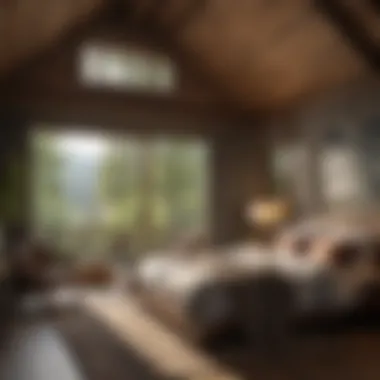
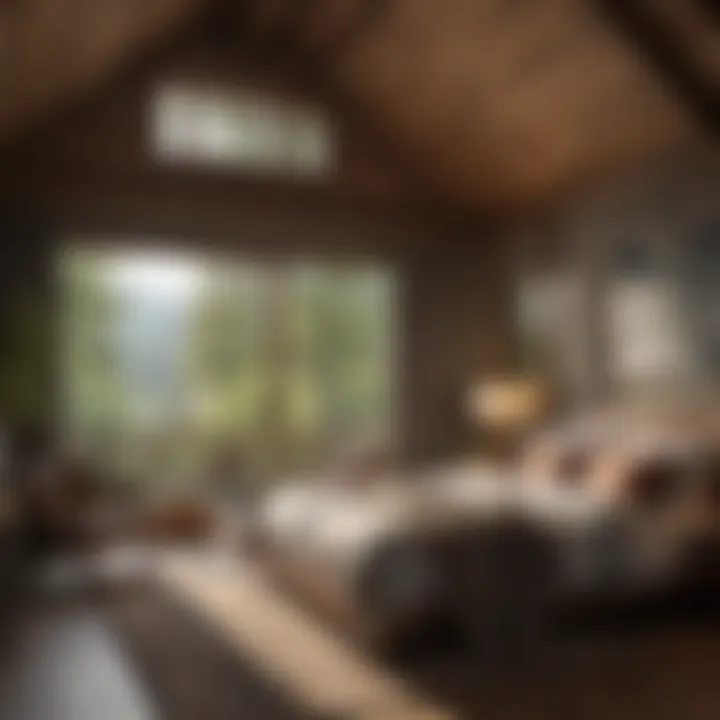
In sum, the choices in furnishings, from functional pieces to the incorporation of textiles, must reflect both personal style and practicality. In a modern cabin, every element should work together like the notes in a symphony, weaving comfort and sophistication into a cohesive narrative.
Lighting Strategies for Cabin Interiors
Lighting is a crucial element in any cabin interior design. It goes beyond mere illumination; it's about crafting moods, accentuating architectural features, and providing functional areas within a space. In a cabin setting, the right lighting can enhance the natural beauty around, making the interiors feel warm and inviting. From cozy evenings by the fireplace to lively gatherings, lighting strategies significantly influence the atmosphere in a cabin.
An effective approach to lighting can elevate the overall visual appeal of a cabin, achieving a delicate balance between form and function. It also adds layers of depth to the space, helping it to adapt to various activities throughout the day. Let's dive deeper into two crucial aspects: Natural Light Maximization and Layered Lighting Techniques.
Natural Light Maximization
Maximizing natural light is an art form that plays a vital role in cabin design. Large windows, skylights, and open spaces allow natural sunlight to flood the interior. This not only reduces reliance on artificial lighting but enhances the overall ambiance, creating a fresh and airy feeling.
- Window Placement: Positioning windows on the south-facing side of the cabin can harvest the most sunlight during the day. Consider floor-to-ceiling windows for a stunning view of nature outside.
- Transom Windows: These small windows sit above doors or larger windows. They can allow light to flow through spaces without sacrificing privacy.
- Reflective Surfaces: Utilizing mirrors or glossy finishes can bounce light around, brightening darker areas while also making the space feel larger.
Taking advantage of natural light not only elevates the aesthetic of a cabin but also contributes to energy efficiency, making it an eco-friendly choice for homeowners.
Layered Lighting Techniques
Layering lighting is essential for creating a versatile and functional cabin. It involves combining different types of lighting to achieve a well-rounded illumination throughout the space. The three primary types include:
- Ambient Lighting: This is the base layer that provides overall illumination. Recessed lighting or ceiling fixtures can serve this purpose, ensuring every corner is well-lit.
- Task Lighting: Focused lighting for specific tasks, such as reading or cooking. Table lamps, under-cabinet lights, and pendant lights can guide you through everyday activities without strain.
- Accent Lighting: Highlights artwork, architectural features, or landscape views. It adds drama and visual interest, creating focal points that draw attention. Spotlights or wall sconces work wonders here.
Balancing these layers allows homeowners to switch between a cozy, inviting atmosphere and bright, functional spaces.
"Lighting can shape the experience of a cabin, steering its atmosphere to match the emotional needs of its inhabitants."
When done right, these strategies not only illuminate a cabin's interiors but can also reflect the owner’s personality and taste. The harmony of light and space creates an inviting backdrop for all the cabin's activities, from tranquil moments of solitude to vibrant gatherings with friends and family.
Decorative Elements and Accessories
In the realm of modern cabin interior design, decorative elements and accessories play a pivotal role in shaping the character and narrative of a space. These items are not mere afterthoughts; rather, they are the finishing touches that weave a story, reflecting the personality of the inhabitant while enhancing the overall aesthetic. From art pieces to carefully chosen fabrics, every accessory contributes to creating an environment that is both inviting and visually appealing.
Art and Personal Collections
Art can be a powerful tool in defining the mood of a cabin. Regardless of the overall style, whether it leans rustic or sleek, the choice of art adds layers of depth.
- Reflections of Personal Taste: The artwork should resonate with the homeowner’s interests, serving as conversation starters and creating connections. For instance, a vibrant landscape painting can bring the surrounding outdoors inside, creating continuity between the natural and interior spaces.
- Curated Displays: Utilizing wall space effectively can turn an ordinary wall into a gallery. The assembly of personal collections—be it family portraits, travel mementos, or local artists’ pieces—can speak volumes about one's journey. Consider using varied frame styles to add visual interest while keeping with a cohesive color palette.
- Texture and Dimensions: Adding three-dimensional art pieces or wall hangings can also play a crucial role. Something like a driftwood sculpture or woven textiles introduces texture and raises the aesthetic stakes.
Nature-Inspired écor
Drawing inspiration from nature is nearly synonymous with cabin design. Integrating natural decor elements can foster tranquility and a strong connection to the surrounding environment.
- Natural Materials: Use items made from stones, woods, or even plant-based materials. Think driftwood or stone coasters that are both functional and decorative. These materials not only evoke a sense of peace but also underscore the cabin's purpose as a retreat from urban life.
- Greenery: Live plants breathe life into any space. Consider adding potted herbs in the kitchen area or larger plants like fiddle leaf figs in living spaces. These choices not only purify the air but also contribute to the cabin’s warmth.
- Biophilic Design Elements: Incorporating elements that mimic nature can be beneficial. This can include using patterns found in nature, such as leaf motifs on cushions or tree bark textures in wallpaper, to create a unified theme that feels organic.
"Incorporating nature into your interior design fosters a sense of harmony and wellness. It's about creating a seamless flow between the indoors and outdoors."
Challenges in Modern Cabin Design
Designing a modern cabin is no walk in the park. This style, which blends comfort with sophistication, does come with its set of hurdles. Understanding these challenges is pivotal for any homeowner or designer aiming to create a harmonious living environment that is both stylish and functional.
One key element to consider is how to harmoniously blend aesthetic appeal with practicality. Modern cabin design often seeks to evoke a feeling of tranquility while accommodating everyday activities. This means that every piece of furniture, every layout choice, and every color must work together, striking a balance between being visually pleasing and serving a purpose. Making choices that hit that sweet spot can be tricky, leaving homeowners stuck between choosing a stylish yet impractical piece or a functional item that lacks character.
Another important consideration is the space in which a cabin resides. Modern cabins often wrestle with the constraints of limited square footage, especially if they are built in scenic but compact locations. This constraint necessitates a thoughtful approach to spatial planning, ensuring that all areas can be used effectively without feeling cramped or disorganized.
In light of these challenges, let’s dive deeper into two core obstacles: balancing style and function, as well as navigating limited spaces.
Balancing Style and Function
When it comes to striking the right balance between style and function, it can feel like walking a tightrope. On one hand, you want your cabin to look like a million bucks, exuding a cozy charm that welcomes all who enter. However, on the flip side, you can't sacrifice usability. A beautifully designed space that doesn't serve your needs is ultimately pointless.
Here are some tips to navigate this balance:
- Select functional furniture: Opt for pieces that serve double duty. A stylish ottoman that opens to store blankets is a wise choice.
- Prioritize quality over quantity: Choose fewer items that stand out rather than filling the space with too many mediocre pieces.
- Think about versatility: Choose colors and materials that can adapt to different styles or seasons without needing a complete overhaul.
By implementing these strategies, you can maintain that cozy, modern aesthetic while ensuring your space functions well for daily life.
Navigating Limited Spaces
Limited space is perhaps one of the most significant challenges faced in modern cabin design. This constraint often leads homeowners to feel like they are fighting an uphill battle. Fear not; with a little ingenuity, you can create a cozy retreat that feels spacious and inviting.
Some ways to make the most of restricted areas include:
- Open concept layouts: Embrace open spaces that create an illusion of roominess. This setup encourages flow and avoids dead corners.
- Use vertical storage solutions: Think shelves that reach for the sky. This not only saves floor space but turns bare walls into functional art.
- Incorporate mirrored elements: Mirrors can reflect light and create depth, making a small space feel larger than life.
"A cabin might be a small space, but with smart planning, it can hold an abundance of charm and character."
Future Trends in Cabin Interior Design
As we look ahead, the realm of cabin interior design is undergoing a transformation driven by evolving consumer preferences and technological advancements. The growing emphasis on personalization and sustainability is compelling designers and homeowners to rethink the way cabins are built and decorated. Understanding these future trends not only inspires creativity but also helps in crafting spaces that are both modern and timeless.
It's no longer just about aesthetics; it's about creating a retreat that resonates with the owner's personality and values. As we delve into the emerging trends in cabin interiors, we uncover key elements that can have noteworthy impacts on functionality, comfort, and overall style.
Embracing Smart Home Technology
One of the most significant trends on the horizon is the integration of smart home technology into modern cabins. This innovation is not just reserved for urban living; remote homes are also stepping up to join this digital revolution.
Imagine waking up in a cabin where you can adjust the temperature from your smartphone or control the lighting with just your voice. This level of convenience enhances the cabin experience, making it more enjoyable and efficient.
Some benefits of smart home technology include:
- Energy management: Smart thermostats and lighting systems can significantly reduce energy consumption, making your cabin eco-friendlier.
- Security enhancements: With smart locks and cameras, homeowners can feel safer even when they are away.
- Convenience features: From automated coffee makers to virtual assistants, these technologies cater to a lifestyle of ease and relaxation.
However, it’s crucial to consider factors like internet connectivity in rural areas and the balance of technology with nature. The aim is not to overshadow the natural beauty surrounding the cabin but to enhance the living experience while maintaining a cozy atmosphere.
Evolving Aesthetic Preferences
As we move further into the 21st century, our collective aesthetic preferences are also shifting. Homeowners are gravitating towards designs that reflect individuality and comfort rather than adhering strictly to traditional styles.
This leads to a few observable changes in cabin interior design:
- Mixing styles: Homeowners are no longer boxed into one specific design theme. A blend of rustic and contemporary elements creates an eclectic vibe that feels personal and inviting.
- Focus on natural materials: The use of organic, sustainably sourced materials is growing. From warm wooden beams to natural stone, these elements are not only visually appealing but also resonate with today's eco-conscious consumers.
- Personalized decor: Accessories that tell a story or remind owners of their travels add character to cabin interiors. This could mean displaying local art pieces or integrating heirloom furniture that brings a sense of nostalgia into the modern setting.
"Home is the place you create, a canvas that reflects who you are beyond the four walls."
As design trends continue to evolve, homeowners find themselves in an exciting position to innovate their spaces, considering both function and aesthetics. The future of cabin interior design promises enriching experiences that marry comfort with modern sensibilities, encouraging a more profound connection to nature and personal expression.







